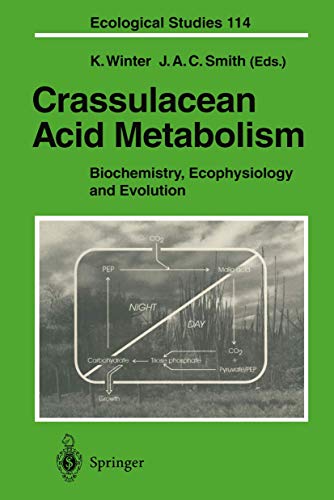Articoli correlati a Crassulacean Acid Metabolism: Biochemistry, Ecophysiology...

New areas of research reviewed in detail in this book include regulation of gene expression and the molecular basis of CAM, the ecophysiology of CAM plants from tropical environments, the productivity of agronomically important cacti and agaves, the ecophysiology of CAM in submerged aquatic plants, and the taxonomic diversity and evolutionary origins of CAM.
Le informazioni nella sezione "Riassunto" possono far riferimento a edizioni diverse di questo titolo.
Le informazioni nella sezione "Su questo libro" possono far riferimento a edizioni diverse di questo titolo.
- EditoreSpringer-Verlag
- Data di pubblicazione1996
- ISBN 10 3642790623
- ISBN 13 9783642790621
- RilegaturaCopertina flessibile
- Numero di pagine488
- RedattoreWinter Klaus
Compra nuovo
Scopri di più su questo articolo
Spese di spedizione:
GRATIS
In U.S.A.
I migliori risultati di ricerca su AbeBooks
Crassulacean Acid Metabolism: Biochemistry, Ecophysiology and Evolution (Ecological Studies) [Paperback ]
Descrizione libro Soft Cover. Condizione: new. Codice articolo 9783642790621
Crassulacean Acid Metabolism: Biochemistry, Ecophysiology and Evolution (Ecological Studies, 114)
Descrizione libro Condizione: New. Codice articolo ABLIING23Mar3113020236466
Crassulacean Acid Metabolism : Biochemistry, Ecophysiology and Evolution
Print on DemandDescrizione libro Condizione: New. PRINT ON DEMAND Book; New; Fast Shipping from the UK. No. book. Codice articolo ria9783642790621_lsuk
Crassulacean Acid Metabolism
Descrizione libro Taschenbuch. Condizione: Neu. This item is printed on demand - it takes 3-4 days longer - Neuware -Crassulacean acid metabolism (CAM) represents one of the best-studied metabolic examples of an ecological adaptation to environmental stress. Well over 5 % of all vascular plant species engage in this water-conserving photosynthetic pathway. Intensified research activities over the last 10 years have led to major advances in understanding the biology of CAM plants. New areas of research reviewed in detail in this book include regulation of gene expression and the molecular basis of CAM, the ecophysiology of CAM plants from tropical environments, the productivity of agronomically important cacti and agaves, the ecophysiology of CAM in submerged aquatic plants, and the taxonomic diversity and evolutionary origins of CAM. 488 pp. Englisch. Codice articolo 9783642790621
Crassulacean Acid Metabolism
Descrizione libro Condizione: New. pp. 488. Codice articolo 2658575767
Crassulacean Acid Metabolism
Descrizione libro Condizione: New. Dieser Artikel ist ein Print on Demand Artikel und wird nach Ihrer Bestellung fuer Sie gedruckt. Crassulacean acid metabolism (CAM) represents one of the best-studied metabolic examples of an ecological adaptation to environmental stress. Well over 5 % of all vascular plant species engage in this water-conserving photosynthetic pathway. Intensified res. Codice articolo 5070738
Crassulacean Acid Metabolism : Biochemistry, Ecophysiology and Evolution
Descrizione libro Taschenbuch. Condizione: Neu. Druck auf Anfrage Neuware - Printed after ordering - Crassulacean acid metabolism (CAM) represents one of the best-studied metabolic examples of an ecological adaptation to environmental stress. Well over 5 % of all vascular plant species engage in this water-conserving photosynthetic pathway. Intensified research activities over the last 10 years have led to major advances in understanding the biology of CAM plants. New areas of research reviewed in detail in this book include regulation of gene expression and the molecular basis of CAM, the ecophysiology of CAM plants from tropical environments, the productivity of agronomically important cacti and agaves, the ecophysiology of CAM in submerged aquatic plants, and the taxonomic diversity and evolutionary origins of CAM. Codice articolo 9783642790621
Crassulacean Acid Metabolism: Biochemistry, Ecophysiology and Evolution (Ecological Studies)
Descrizione libro Paperback. Condizione: Brand New. reprint edition. 481 pages. 9.20x6.10x1.10 inches. In Stock. Codice articolo x-3642790623
Crassulacean Acid Metabolism
Print on DemandDescrizione libro Condizione: New. Print on Demand pp. 488 49:B&W 6.14 x 9.21 in or 234 x 156 mm (Royal 8vo) Perfect Bound on White w/Gloss Lam. Codice articolo 51016776

